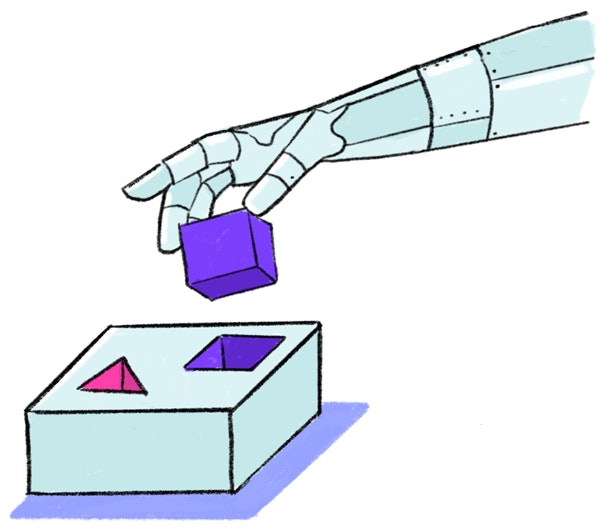You know those toy block sets, where you have to push a bunch of brightly colored shapes through matching slots? Red star block goes into red star slot, green triangle block goes into green triangle slot. A lot of our work in customer service is essentially the same thing.
A password request comes in, we identify it, match it to the password request solution, and the queue flows ever onward.

If that’s all, or even most, of what we mean by "customer support," then we’d be right to worry about the impact of AI and machine learning on our careers. That sort of pattern matching is exactly what computers are able to do well. It’s not coming anytime soon, but it is inevitable that automation will answer or assist with the more repeatable and well-structured requests.
That’s good news for most customer service professionals, who never really enjoyed being glorified knowledge base search engines. The most enjoyable parts of our roles are the ones that demand greater skill, encourage deeper engagement, and trigger our curiosity. Those are also the parts that are much harder to automate.
The future of humans in customer service is not in pattern matching, it’s in customer discovery. It’s in understanding who our customers are, what they love, what they hate, what they need to get done, and where they get stuck. Knowing those answers is valuable not just to support teams, but to every part of our organizations.
Curiosity and the future of support
If I chose a single word to explain the value of real people in customer service, it would be "curiosity." Curiosity is simply the hunger to learn — that itch you feel when you identify something you need to know more about.
While there are competing theories for the neurological basis of curiosity, research has connected it to a raft of helpful behaviors and attributes.
Curious people:
Have greater motivation— according to the "information gap" theory, curious people have an almost physical craving to learn.
Persevere longer— curiosity is strongly associated with grit, the willingness to get up and keep going. Grit is a good predictor of long-term success.
Remember better— the mental state of curiosity seems to improve overall recollection, no matter what people are curious about.
Those are positive characteristics, but do they translate to delivering better customer service? Or is curiosity just a personality quirk ranking somewhere below first-aid skills and pronouncing "GIF" correctly on the list of important life skills?
Here’s how bringing human curiosity back to customer service will create more valuable customer experiences and develop customer insights.
How curiosity improves customer service
1. Focus on individual customers
"One size fits all" service is far too common. Being curious about your customers helps you treat each person as a unique individual with their own context, goals, challenges and skills.
2. Connect more deeply
Ira Glass names curiosity as the key to a great interview. He says that curiosity works because people mostly feel like he does:
Listen to the full interview: Conversations with Richard Fidler.
Being curious about someone helps us to connect more deeply, and from that connection will come more honest and useful information and better service.
3. Diagnose complex problems
The key to problem solving is asking the right questions and collecting information from multiple sources. When you’re curious about customers and their situations, it’s easier to uncover the information you need.
4. Unlock customer insights
When you’re not content to just answer what was asked, and instead you open up the conversation, you will discover all sorts of new information. You may find people using your products in unexpected ways, new types of customers your marketing team never knew about, or service problem areas that were previously invisible to you.
Support team members who are able to deploy their curiosity can do so much more than merely answer customer questions. Support becomes less about heroically flying in to the rescue and more about walking alongside your customers.
How to develop your curiosity
Some people are more innately curious than others, and you can even test for curiosity, but everybody can develop their own curiosity through some simple, practical steps.
1. Create psychological safety
If you’re leading a team, you can help create an environment in which curiosity can flourish.
Make it safe for people to ask "silly" questions, as long as they are curious about getting the right answer.
Make sure your performance metrics don’t only incentivize short conversations and deflection. Allow for longer conversations.
Let your team explore. Give people explicit time to investigate things that they are curious about, and celebrate their findings.
2. Learn the art of conversation
Being able to maintain a conversation, show genuine interest in a person, and steer back onto the necessary topic are great life skills, as well as great support skills.
You can learn this doing email support, but if you get into live chat then your learning will be greatly accelerated because of real-time feedback on what’s working and what isn’t.
Start at TED for some great conversational skill building!
3. Ask better questions
Remember when you first started your job? Everything was new, and lots of things seem confusing or unclear. Soon enough, though, it all faded into the background. Try looking at your work situation again, and ask some new questions:
What else could we do here?
Why is it this way?
Who knows more about this?
What if we just didn’t do it?
What are we trying to get done?
Why does this matter?
4. Sit down, be humble
With due respect to Kendrick, you could actually stand. Reclining would be fine, too. It’s the being humble that will help you build your curiosity. When you’re humble, you admit the possibility that you don’t know everything, and you’re open to learning from any source.
5. Dig deeper
Stop trying to know everything about everything. It’s not possible, and when you try, you end up knowing almost nothing about a lot of areas. Shallow knowledge is not enough to trigger that information-gap curiosity.
Find some areas to dig deeper, realize how much you don’t know, and feel that curiosity rise.
Be like Alice
"Curiouser and curiouser," cried Alice in Lewis Carroll’s Alice in Wonderland.
Customer service should be more than "fixing what’s broken." Engaged, empowered customer support teams can be the driving force behind your business growth, by connecting you more deeply with your customers and their goals. At Help Scout we call this “support-driven growth.”
Let the machines assist with the repetitive pattern matching work, and create space for humans to be the most creative, curious, messy, relational creatures they can be.
Further reading on curiosity and its role in support:
Michel de Montaigne — The most curious philosopher and his ideas about skepticism and learning.
The 5 Whys model for problem solving — Ask better questions!
If I Understood You, Would I Have This Look on My Face? — Alan Alda explains communication.
Schools Are Missing What Matters About Learning —Hint: It’s curiosity.
8 Habits of Curious People — Willingness to be wrong, and 7 more!
The power of curiosity — Richard Fidler explores curiosity in his life.
Assessment: What’s Your Curiosity Profile? — Are you as curious as you think?
Early childhood curiosity and kindergarten reading and math academic achievement



